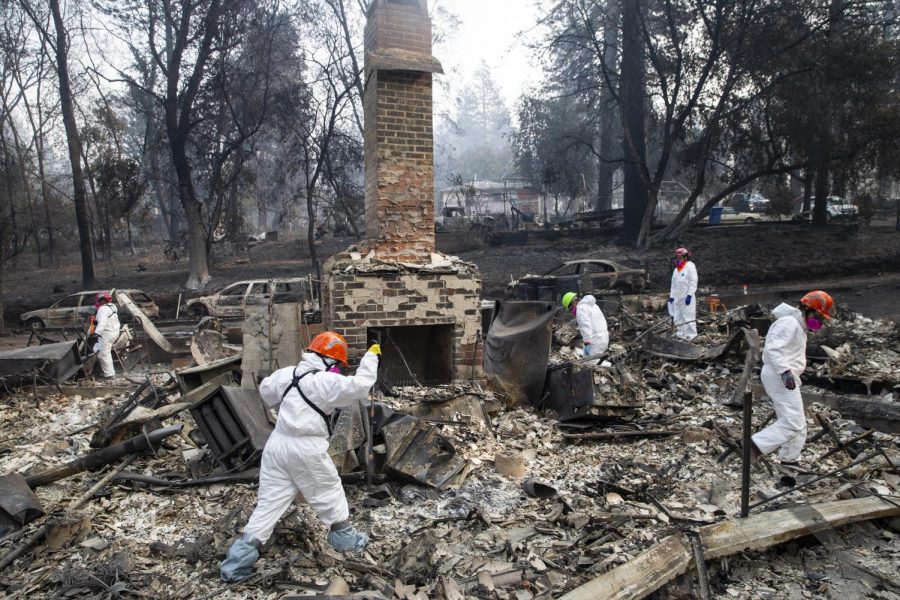California fire continues to affect students on campus
Photo courtesy of Tribune News Service
Search and rescue teams inspect the grounds of a house burned down by the Camp Fire along Boquest Boulevard on Nov. 17 in Paradise, California. University students from the area stay updated from afar as their family and friends recover.
Dec 3, 2018
When Muskaan Sawhney returned home to San Ramon, California, for fall break, she was shocked by the smoke in the air and the clouds in the sky. Before leaving the airport, she bought a face mask to protect herself from the poor air quality.
Sawhney, freshman in LAS, first heard about the California wildfires while on campus, but she didn’t initially grasp the scope of the fires or the impact they were making until she spoke to friends and family who had been affected.
“The people from California here didn’t realize how big of a fire it was compared to previous fires because we often have a lot of fires,” Sawhney said. “It wasn’t until we were talking to our family and realizing the air quality had decreased, and it was even bad for us two hours away from the fire — that’s when we realized it’s actually worse than previous years.”
Given the University’s biggest out-of-state student population comes from California, many students like Sawhney were affected.
Sahaj Putcha, freshman in LAS, returned to his hometown Cupertino, in the southern bay area, where he said aside from the air quality and fewer people outside as a result, life wasn’t noticeably different. However, his dad, who works in San Francisco, saw a difference in air quality.
Get The Daily Illini in your inbox!
Also, some of his friends’ schools in northern California were shut down.
Arden Rowell, professor in Law at the University, sees air pollution as the “silent killer” of these wildfires. Wildfires emit carbon, solids and fine particulate matter. Arden said fine particulate matter is “so tiny that if you lined up a human hair, you could put 30 of them across.”
As a result, when breathed in, they get deep into the lungs and cause, and worsen, health problems.
“The 44 people who have died because of the fire grossly underestimates the number of people actually killed,” Rowell said. “Most recent estimates are wildfires kill 14,000 people a year from air pollution, and that number is increasing.”
People who suffer from cardiovascular and respiratory problems are already vulnerable; therefore, exposure to air pollution makes their conditions worse over time.
Rowell attributes causes of the fires to an excess of dry vegetation, climate change and current policy. While eliminating all fire risk is impossible, she said periodic planned burns can be a preventative measure against the catastrophic fires which are becoming increasingly common.
Planned burns are controlled fires that are purposely set and put out by fire managers to get rid of dry vegetation that has built up. If dry vegetation is not removed, it only adds fuel to the fire.
“The thought process is very intuitive,” Rowell said. “The less there is to burn, the less burning there will be.”
Yet, current wildfire policy and public attitude is not in favor of planned burns.
The Clean Air Act mandates states meet national air quality standards by reporting greenhouse gas emissions, but the exceptional events clause allows states not to report greenhouse gases emitted by wildfires; however, they do make states report greenhouse gas emissions for planned burns.
Rowell said if states count the greenhouse gas emissions by wildfires, states would consequently have to put more restrictions on other sources of greenhouse gas emitter businesses, which is generally unfavorable.
“In the past, federal environmental regulations potentially, inadvertently incentivized wildfires by disincentivizing planned burns,” she said.
She also explains people are fearful of wildfires, so they instinctively want to put them out right away. By doing this, they are not removing dry vegetation and creating conditions for a bigger and more dangerous fire.
New policies, like Senate Bill 901 in California, are moving toward incorporating wildfire safety prevention practices like planned burns. However, the wildfire season in California continues to grow longer as a byproduct of climate change.
The recent national climate assessment projects a rise in catastrophic natural disasters across the United States.
Rowell said natural disasters here in the Midwest will not be “an immediate salient disaster like a wildfire,” but they will include precipitation changes, ecosystem degradation and increased floods and droughts.
This will affect agriculture in C-U because increased temperatures lead to a longer harvest season, and unpredictable weather will make it harder for farmers to choose what to plant and when.
Even the extreme, seemingly far removed coastal natural disasters like wildfires occurring thousands of miles away still affect people here in the Midwest.
Grace Robbins, freshman in Engineering, received an email from her extended family on Nov. 9 explaining they had to evacuate their home in Thousand Oaks, California, and were turned away from an evacuation center because it was at capacity. She learned her grandpa in hospice care also had to be moved.
There are campus efforts combating climate change, but Putcha said all people have a social responsibility to help wildfire victims.
Putcha said this is a time when California needs to come together.
“I know it’s easy to say, but not just California, even the United States as a whole, needs to help out the victims in any way possible,” he said. “The government maybe needs to be stepping in by giving aid. I know they already have been, but helping these people get their lives back after a horrible tragedy like this, I know it might be hard for them. I think it’s the government’s job, and not just the government’s job, but the job of us as citizens to do what we can to help them get back on their feet.”






